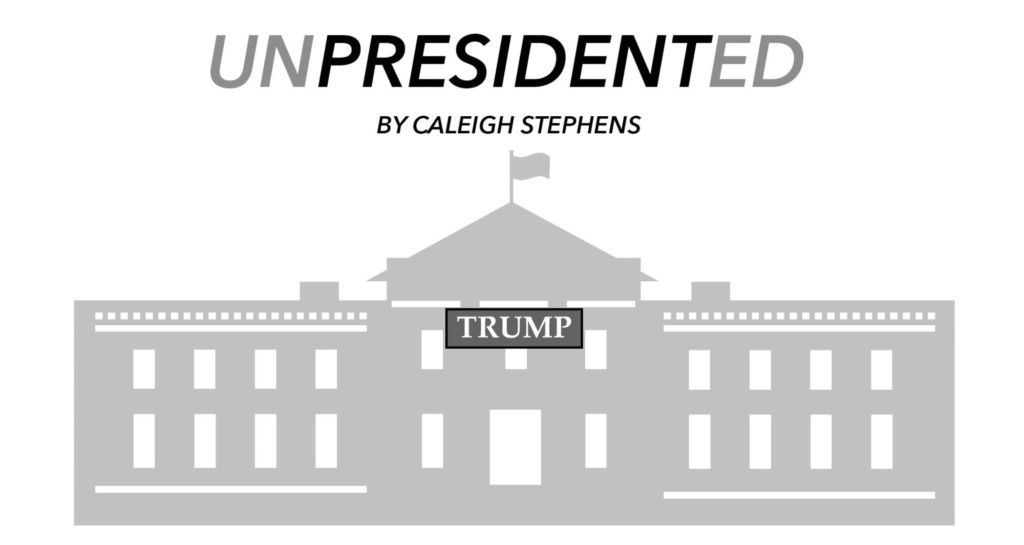
“UnPresidented” is a new column discussing the transition and first days of the Trump administration.
Until Tuesday, immigration policy under President Trump’s administration only laid the foundation for a ridiculous border wall and thrived on vague threats of increased action. That all changed with the recently released directives from the Department of Homeland Security, which are representative of a concrete shift away from Obama-era immigration policy. Under Trump’s direction, the department has created new policies and practices, a sampling of which include increasing deportations, stripping privacy protections for undocumented immigrants, establishing more detention centers and increasing the number of enforcers. The Deferred Action for Childhood Arrivals (DACA), which allows for some legal protections of undocumented children, is still in place, but it’s position is precarious as it may be repealed yet.
The policies are harsh and ignore the lack of available resources for enforcement. It is simply not possible to quickly conjure up the Border Patrol agents and detention centers called for in the directives. But what is most troubling is flawed picture of immigration that Trump has publicized.
From all the nativist rhetoric espoused by the President, one might get the impression that the country is currently suffering a highly problematic and rising influx of undocumented immigrants. However, 2016 Pew Research study found that the number of undocumented immigrants in the U.S. began to decline in 2007-2008 and has since stabilized, with most states seeing no statistically significant change in the size of their undocumented immigrant populations from 2009 to 2014. Currently, undocumented immigrants comprise only 3.5 percent of the total U.S. population, according to the same Pew study.
The xenophobic immigration policies put in place thus far are based on a few misguided principles: that immigration is hurting our economy as native-born Americans are losing out on jobs owed to them by birthright; that immigrants are bringing crime and drugs; and that immigrants are coming in droves to use public services without paying taxes.
Data from a 2016 study by the National Academy of Sciences has shown that a sizeable foreign-born population does not have the devastating economic impact Trump claims. The study found that immigration had a very small impact on native wages in the long-run. With a U.S. economy of $18 trillion, the entrance of immigrants into the workforce ends up a relatively minor factor. It is simply untrue that immigration “continues to reduce jobs and wages for American workers,” as Trump said in an August policy address on illegal immigration.
The truth is that the long-run growth of our economy is dependent on a steady workforce. As in most other developed countries, the U.S. native-born population is aging. Census data projects that the proportion of elderly citizens will skyrocket in the near future, with predictions that by 2030, more than 20 percent of U.S. residents will be ages 65 and over. In 2010, only 13 percent of the U.S. population was elderly, an increase from the 9.8 percent proportion in 1970.
An older population requires young workers to support rising Medicare and Social Security costs and fill in the required labor force. Luckily, the immigrants “flooding” the country are largely young and entering the labor force. While undocumented immigrants are only 3.5 percent of the population, according to Pew data, they make up 5 percent of the labor force. Ninety-two percent of undocumented immigrants and 76 percent of lawful immigrants are between the ages of 18 and 64, compared to 60 percent of U.S. citizens.
This country is in desperate need of future economic growth and innovation, something that is unachievable without loose immigration policies.
As evidenced by Trump’s claims at his rally on Saturday, the president’s idea of illegal immigrants includes only “gang members and drug dealers.” Pew data reveals that these assertions are backed in racism and xenophobia, not actual fact: a 2013 study found that crime rates of first-generation immigrants are significantly lower than both those of native-born Americans and second-generation immigrants. The vast majority of immigrants are not bringing crime into the country, but rather come in search of a better life and economic future.
There’s a prevalent idea that undocumented immigrants come into this country and drain resources meant for the native-born population while paying no taxes. This claim has been furthered by Trump himself, as he said in an August speech focusing on immigration that “illegal workers draw much more out from the system than they can ever possibly pay back.”
However, a 2010 study by the Social Security Administration found that its finances were positively affected by undocumented immigrants, estimating a gain of $13 billion in payroll taxes as a result, with only $1 billion in payout.
While not all undocumented immigrants pay taxes, data from the nonpartisan Institute on Taxation and Economic Policy found that about half of undocumented workers in the United States pay income taxes. The study also found that sales and property taxes paid by undocumented immigrants resulted in $10.6 billion in state and local taxes in 2010.
The road to documentation is not easy, and as a result, the only option for many immigrants has been to enter the country illegally. And 2015 Pew Research data finds that a large majority of Americans on both sides of the aisle support an easier path to legal status. The right path for immigration policy isn’t increased deportations―it’s decreased xenophobia.







